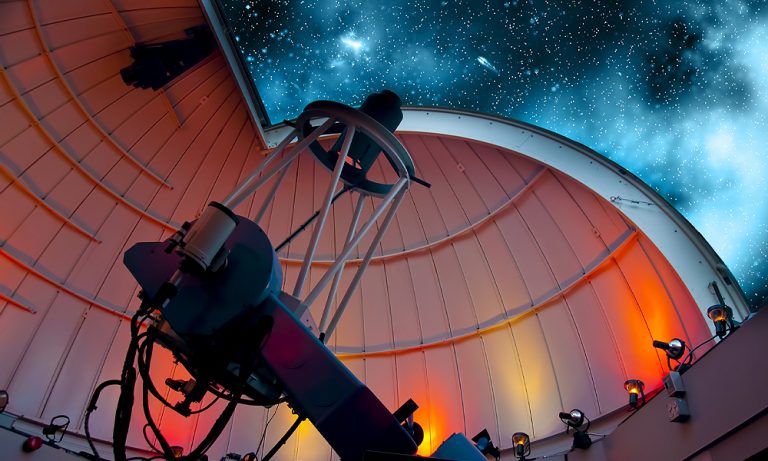12 Best Telescopes for Deep Space Objects [2024]
Deep space objects are enormous. There are several hundreds of deep-sky objects whose angular size is larger than the largest planets Jupiter and Saturn.
So why can’t you easily see them? They are very faint and you need a large aperture to capture them.
The best telescopes for deep space have a large aperture, are easy to use, and are reasonably portable.
Best Telescopes for Deep Space
1. Orion SkyQuest XT8 Classic Dobsonian Telescope
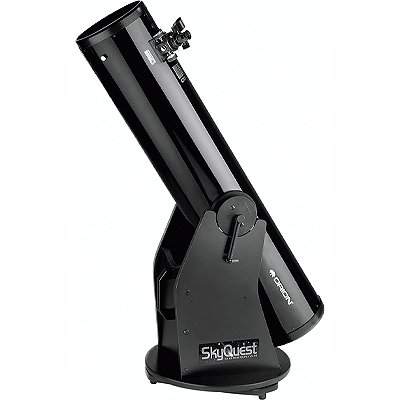
The Orion SkyQuest XT8 Classic Dobsonian Telescope carries a very good price for a large 8” aperture deep space telescope.
With this scope, we viewed the moon, planets, and star clusters.
We were able to see faint nebulas and galaxies through the telescope that we did not see with other models.
This best deep sky telescope is a great investment for a life-time of stargazing and will take you from beginner to intermediate levels.
It comes with a sturdy non-motorized Dobsonian base mount that moves horizontally and vertically. The mount keeps the telescope perfectly balanced for point-and-view ease of use.
Included in the set is a 2″ Crayford focuser that accepts 1.25″ and 2″ telescope eyepieces. Also included is an EZ Finder II reflex sight, a 25mm Sirius Plossl eyepiece, and Starry Night software for download.
It is a large scope and fairly heavy, so it is not ideal if you plan to travel with it. Rather mount it in a fixed place in your home and enjoy hours of fun with a telescope that can see other galaxies.
What we liked
- Very affordable telescope that can see galaxies
- Large 8” aperture for bright views
- 1 25mm Sirius Plossl eyepiece
- 2″ Crayford focuser that accepts 1.25″ and 2″ telescope eyepieces
- Great telescope for planets and galaxies
- Sturdy Dobsonian base mount
- Starry Night software for download
What we didn’t like
- Heavy and large, not ideal for travel
- Not motorized
- Includes collimation cap, but no instructions
Type: Dobsonian Reflector telescope
Aperture: 8”
Focal length: 1200 mm
Focal ratio: f/5.9
Limiting stellar magnitude: 14.00
Weight: 41 lbs. (18.5 kg)
Best for: Entry-level to intermediate
2. Sky-Watcher 12″ Collapsible Dobsonian Telescope
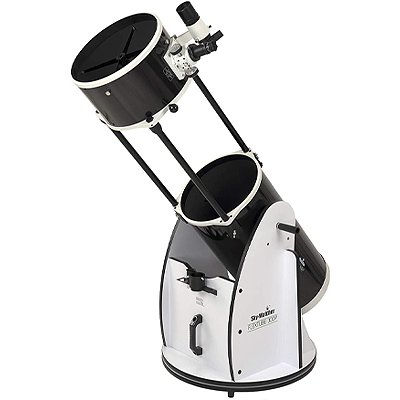
This Sky Watcher 12” version is virtually the same quality as the 8” version, but with a larger aperture, longer focal length, a far better fine-tune focuser, and not much more weight to it, which is good for portability.
If you are a backyard astronomer and you don’t plan to travel to dark locations, then this semi-compact design can be great. Just don’t forget to use your UHC filter when stargazing in your backyard.
Same as 8” version, I would strongly recommend you to immediately buy at least the cheap aspherical eyepieces because the included Plossls are garbage for this kind of a telescope.
Its larger aperture and longer focal length can utilize the best eyepieces out there. In order to experience the full potential of this 12-inch scope, maybe you should buy at least one high-end eyepiece with an ultra-wide apparent field of view at 100°.
What we liked
- Very good aperture size
- DSO hunter
- High contrast for DSO
- Nice, large focal length
- Collapsible tube
- Well fine-tune focuser
- Great overall performance
- Nice viewfinder
- Easy to collimate
What we didn’t like
- Very bulky rocker base
- Both eyepieces are low quality
Type: Collapsible Dobsonian reflecting telescope
Aperture: 12”
Focal length: 1500 mm
Focal ratio: f/5
Limiting stellar magnitude: 14.9
Weight: 58 lbs. (27 kg)
What’s special about it: Great for advanced users, semi-compact, very powerful telescope.
3. Orion SpaceProbe 130ST EQ Reflector Telescope
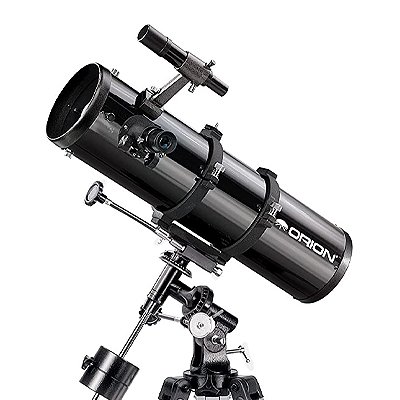
The next telescope to see galaxies that we reviewed was the Orion SpaceProbe 130ST EQ Reflector Telescope 200.
Our aim was to find the best telescope for deep space objects and we were very impressed.
At a very reasonable price, you get exceptional value for money.
The scope has a 5.1″ aperture for awe-inspiring deep space observation.
We enjoyed observing brighter galaxies, the moon, star clusters, and nebulas. It has a short 24” optical tube, which makes it very portable and we took it along on the weekend away from the city lights.
We found this to be the best telescope for viewing galaxies. The scope comes with 2 eyepieces, a 25mm, and a 10mm Sirius Plossl. The Shorty 2x Barlow doubles the magnification of the eyepieces.
We used the Orion Telescope Observer’s Guide book to get us started on viewing nebula through a telescope and were soon on our way to exploring deep space objects.
What we liked
- Well priced for exceptional features
- 5.1” aperture for bright views
- 2 eyepieces, 25mm (26x) and 10mm (65x) Sirius Plossl
- Shorty 2x Barlow included to double the magnification
- Best telescope to see galaxies
- Short length tube is very portable
- Orion Telescope Observer’s Guide book
What we didn’t like
- May not suit more experienced stargazers
- Not motorized
Type: Reflecting telescope
Aperture: 5”
Focal length: 650 mm
Focal ratio: f/5
Limiting stellar magnitude: 13.2
Weight: 24.2 lbs. (10.9 kg)
Best for: Entry-level and intermediates
4. Sky-Watcher 8″ Collapsible Dobsonian Telescope
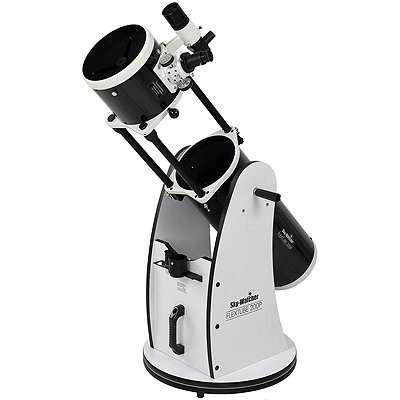
Eight inches of aperture makes this a mid-range scope for the beginners and more serious astronomers.
The collapsible tube makes it more compact and helps with portability, but the rocker mount, though very steady, is still bulky to transport.
Dobsonians are always easy to use, easy to collimate, easy for maintenance, most of them are affordable, and you get great value for money.
There are two eyepieces in the box 10 mm and 25 mm Plössl, but those are just mediocre to low grade. I would recommend you to immediately buy the cheap aspherical eyepieces or something better in order to unlock the great potential that this telescope possesses.
Although the manufacturer quotes that the maximum magnification is at 400x, with this scope, you can enjoy the highest useful magnifications at around 120x with mid-range eyepieces and push the limit to 150x with high-end eyepieces if you are buying this telescope for deep space objects than it’s the light-gathering power which matters more than magnification.
Although I prefer red dot scopes, this one comes with a very nice right-angled 8X50 viewfinder. You can easily replace it or attach a red dot next to the viewfinder. Because of its larger aperture, for observing the Moon, you’ll need an ND-8 filter, or maybe a variable ND filter could be an even better choice.
What we liked
- Wide aperture
- Collapsible tube
- Nice viewfinder
- Nice long focal length
- Great price for 8-inch scope
- Easy to use
- Teflon rocker mount bearings
What we didn’t like
- No fine focusing
- Bulky rocker base
- Eyepieces are low quality
Type: Collapsible Dobsonian reflecting telescope
Aperture: 8”
Focal length: 1200 mm
Focal ratio: f/6
Limiting stellar magnitude: 14.2
Weight: 53 lbs. (24 kg)
What’s special about it: Great for beginners, semi-compact, quite powerful.
5. Orion 8944 SkyQuest XT6 Classic Dobsonian Telescope
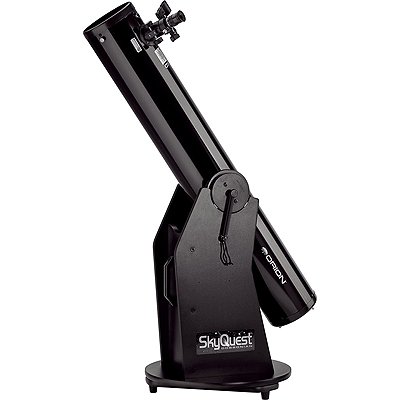
This Dobsonian has an unbeatable price; you can justify buying it with only using it once a year. Definitely the best beginner Dobsonian telescope you can find.
Nice 6″ (150 mm) aperture at an amazing price that makes all the rest sub 6” telescopes obsolete.
With this one, you can enjoy the deep space nebulae with adequate clarity in good detail.
With this 6” you can observe the entire Messier catalog objects, a good chunk of NGC and IC catalog, and of course, the Moon, Moon’s craters, and the planets.
You can keep on using this scope even after you buy a mammoth 16”+ so you can have the largest DSO from end to end in your field of view.
What we liked
- Great value
- Great for beginners
- Easy to assemble
- Excellent focal length
- Very good for viewing the Moon
- Great for planets
What we didn’t like
- No fine focusing
- Very bulky tube and mount
- 20 mm Plossl eyepiece
- Sliding could be smoother
- Very low eyepiece position for lower altitude objects
Type: Dobsonian reflecting telescope
Aperture: 6”
Focal length: 1200 mm
Focal ratio: f/8
Limiting stellar magnitude: 13.5
Weight: 34.4 lbs. (15.8 kg)
What’s special about it: Amazing price, great for beginners.
6. Orion StarBlast 4.5 Astro Reflector Telescope
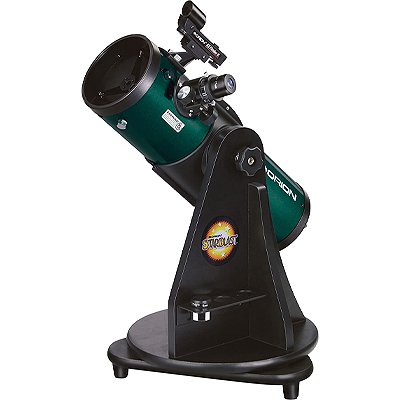
The Orion StarBlast 4.5 Astro Reflector Telescope is a great compact grab-and-go telescope, ideal for beginner and intermediate stargazers.
What we enjoyed about this deep space telescope is the sturdy table-top base. It made it very easy to set up and operate.
The base is a manual altazimuth with smooth controls for the tracking of celestial objects.
We were easily able to keep the object in the eyepiece without losing sight of it. The galaxy telescope has a large 4.5″ aperture, which gave bright and clear views of the moon, solar system planets, and deep space objects like star clusters and nebulas.
It comes with two Explorer II 1.25″ Kellner telescope eyepieces, a 17mm, and a 6mm. It also has an EZ Finder II reflex sight for easy aiming. There is an eyepiece rack to store the components and we downloaded the Starry Night astronomy software, which provided hours of fun.
Weighing only 13 lbs, it is light enough to take along on a weekend away for some serious night sky explorations.
What we liked
- Well priced
- 4.5” aperture for bright views
- 2 Kellner eyepieces – 17mm and 6mm
- Great for viewing the Moon and deep space planets
- Table-top altazimuth mount
- Lightweight to move around
- Slow-motion controls for ease of use
What we didn’t like
- May be too simple for professionals
- Not motorized
- Table-top mount may not suit all users
Type: Orion reflector telescope
Aperture: 4.5”
Focal length: 450 mm
Focal ratio: f/4
Limiting stellar magnitude: 12.9
Weight: 13 lbs. (5.89 kg)
Best for: Entry-level and intermediates
7. Celestron NexStar 127SLT Computerized Telescope
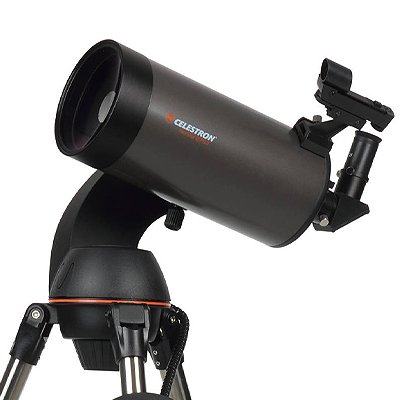
We were super excited to try out the computerized Celestron NexStar 127SLT telescope.
Having a scope that automatically tracks a celestial object is a dream, after using manual models. We specifically wanted to see a galaxy through a telescope.
Carrying a very acceptable price, this scope is ideal for a family growing from entry-level to intermediate deep space astronomy.
It is extremely portable for packing into a car for a weekend away from the city lights. The scope features a Maksutov-Cassegrain Optical Design with a 127mm (5”) aperture.
The large-high-quality lens gathers enough light to give stunning views of the solar system and deep space objects. We were able to see Saturn’s rings, Jupiter’s cloud bands, and the craters on the Moon. This is a great telescope to see nebula.
This best telescope for deep space viewing is easy to use with the Celestron Skyalign functionality. Simply center any three bright objects in the eyepiece and the NexStar SLT aligns with the night sky. It comes with a Red Dot StarPointer finderscope and 2 eyepieces, a 25mm, and a 9mm.
What we liked
- Very well priced for exceptional features
- Large 5” aperture
- Motorized mount
- Great telescope for deep space viewing
- Very portable
- Celeston Skyalign functionality to pin-point and track objects
- Top rated astronomy software programs for an interactive sky simulation
What we didn’t like
- Computerized functions may not suit all users
Type: Maksutov-Cassegrain Telescope
Aperture: 5”
Focal length: 1500 mm
Focal ratio: f/12
Limiting stellar magnitude: 13
Weight: 18 lbs. (8.16 kg)
Best for: Beginners to intermediates
8. Meade Polaris 90mm German Equatorial Refractor Telescope
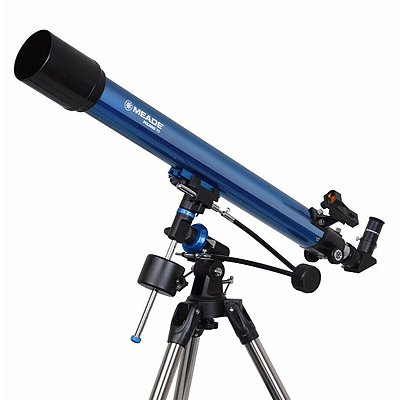
The next telescope we reviewed was the Meade Polaris 90mm Telescope.
Made with German precision, it wowed with clear, crisp views of the night sky.
This telescope is ideal for beginner to intermediate stargazers and will last for years.
We enjoyed the very stable Equatorial mount with slow-motion controls.
It allows you to keep an object in view very easily without it jumping around in your eyepiece. The Meade refractor telescope comes with 3 eyepieces that provide a choice of low (26mm), medium (9mm), and a high (6,3mm) powered magnification.
We successfully viewed craters on the Moon and observed planets, star clusters, nebula, and galaxies. The scope is easy to use with a Red Dot Viewfinder helps you point directly at objects you want to observe.
The nebula telescope includes an accessory tray to store your accessories while observing. To add to the excitement, it comes with a Bonus Autostar Suite Astronomy planetarium DVD, which offers over 10,000 celestial objects.
What we liked
- Well priced
- 3.5” aperture for bright views
- 3 eyepieces for low, medium and high magnification
- Top quality telescope for galaxy viewing
- Portable and easy to move around
- Slow-motion controls for ease of use
- Bonus Autostar Suite Astronomy planetarium DVD
What we didn’t like
- Not motorized
- May be a bit clumsy for some
Type: Refractor telescope
Aperture: 3.5”
Focal length: 900 mm
Focal ratio: f/10
Limiting stellar magnitude: 12.2
Weight: 20 lbs. (9 kg)
Best for: Entry-level and intermediates
9. Orion StarBlast 6i Intelliscope Reflector Telescope
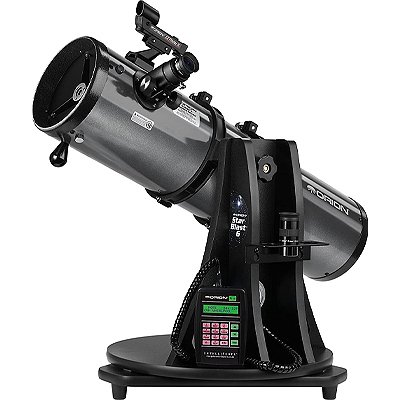
If you are looking for one of the best telescopes for deep space to take on vacation, the Orion StarBlast 6i Intelliscope Reflector Telescope is the perfect choice.
It is well priced and ideal for a family starting as beginners and wanting to grow into intermediate stargazers.
What we enjoyed most on this powerful telescope was the portability and the table-top mount that made it so easy to set up and operate.
This 6″ long range telescope comes with Orion’s IntelliScope computerized object location system.
This allowed us to find any celestial object by using the easy-to-use handheld locator. It has a 750mm focal length, which gives clear, crisp images of brighter deep space nebula, galaxies, and distant star clusters.
These deep space telescopes come with 2 eyepieces, a 25mm and a 10mm Sirius Plossl 1.25″. It also offers an eyepiece rack, EZ Finder II aiming device, and Starry Night Software.
What we liked
- Very well priced for exceptional features
- Large 6” aperture
- 2 eyepieces, a 25mm and a 10mm Sirius Plossl 1.25″
- Table-top motorized mount
- Best telescopes for viewing galaxies
- Lightweight and very portable
- Easy to use with the handheld locater
What we didn’t like
- Computer scope may not suit all users
- Tabletop mount is not for everyone
Type: Reflector telescope
Aperture: 6”
Focal length: 750 mm
Focal ratio: f/5
Limiting stellar magnitude: 13.6
Weight: 25 lbs. (11.3 kg)
Best for: Entry-level to intermediate
10. Orion 8″ f/3.9 Newtonian Astrograph Reflector Telescope

Now that we are hooked on stargazing, we wanted to try some astrophotography.
The Orion 8″ f/3.9 Newtonian Astrograph Reflector Telescope came highly recommended and it did not disappoint.
With a large 8” aperture and an 800mm focal length, it gave us powerful photos of deep space objects.
The design features 9 internal baffle rings, an extended tube length in front of the focuser, and a flat-black interior that combine to provide exceptional image contrast for wide-field astrophotography.
Using the included extension adapters, we were able to see the moon, Messier objects, and everything in between. It has a low-profile Crayford-style focuser, which makes it easy to perform minute focus adjustments.
On the con side, the scope does not come with a mount. You need to purchase one separately, which adds to the price. It will work with most equatorial mounts designed for astrophotography use.
What we liked
- Well priced for a high-quality scope
- Exceptional wide-field astrophotography
- Large 8” aperture
- Stunning visual views of the moon, Messier objects and everything in between
- Comes with included extension adapters
- Unique design with 9 internal baffle rings and extended tube length in front of the focuser
- Smooth adjusting focuser
What we didn’t like
- Better suited for astrophotography
- Does not come with a mount
Type: Reflector Telescope
Aperture: 8”
Focal length: 800 mm
Focal ratio: f/3.9
Limiting stellar magnitude: 14.2
Weight: 17.5 lbs. (7.9 kg)
Best for: Intermediates doing astrophotography
11. Orion 10023 SkyQuest XX12i IntelliScope Truss Dobsonian Telescope
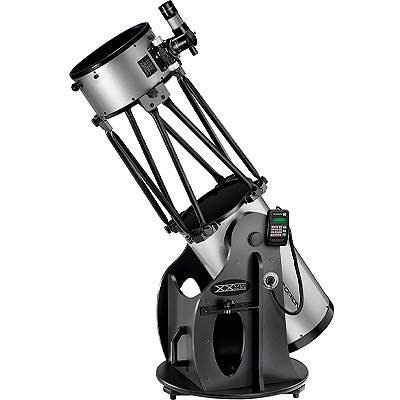
Sometimes you may like the Push-To telescope. Orion SkyQyest XX12i is probably the most compact and affordable Push-To telescope out there.
Although Dobsonian GoTo and Push-To are not my cup of tea, somebody else might enjoy this kind of setup.
In order to use the Push-To system, you need to set up the IntelliScope system with a vertical position and 2-star alignment.
After that, the system is all set up and the hand controller will guide you to the location of the desired object.
If you want to view the planets, you’ll need to enter the correct date and time as well. This is a much more compact version of a Dobsonian reflecting telescope than the previously mentioned Sky-Watcher scopes.
First of all, the tube disassembles into three segments, one where the primary mirror is, one segment with the secondary mirror, and truss poles as the third part. The rocker base (mount) disassembles into smaller parts as well without needing any tools.
Even with this scope, there are two eyepieces in the box. The first one is a 10 mm Plossl, which is complete rubbish and the 35 mm, 2” Plossl is somewhat useful for larger DSO, but you won’t get much of a contrast with it.
That’s why I would recommend buying at least the cheap aspherical eyepieces for a start, and later you should definitely buy one high-end eyepiece between 10 mm and 15 mm with an ultra-wide apparent field of view at around 100°.
What we liked
- Nice and smooth alt-azimuth movement (panning and tilting)
- Very large 12” aperture
- Free Starry Night software
- Real DSO hunter
- High contrast for DSO
- Large focal length
- Very compact scope and base
- Very portable
- 14,000 DSO database
- Fine-tune dual-speed (11:1) Crayford focuser
- Amazing overall performance
- 9×50 finderscope
- Cooling fan
What we didn’t like
- Price
- Longer time for full assembly
- Eyepieces with low-quality optics
- Need batteries for the hand controller
Type: IntelliScope (Push-To) Truss Dobsonian Telescope
Aperture: 12”
Focal length: 1500 mm
Focal ratio: f/5
Limiting stellar magnitude: 15.1
Weight: 83 lbs. (38 kg)
What’s special about it: Very compact when disassembled, great portability, very powerful telescope, great for DSO hunting.
12. Orion 8968 SkyQuest XX16g GoTo Truss Tube Dobsonian Telescope
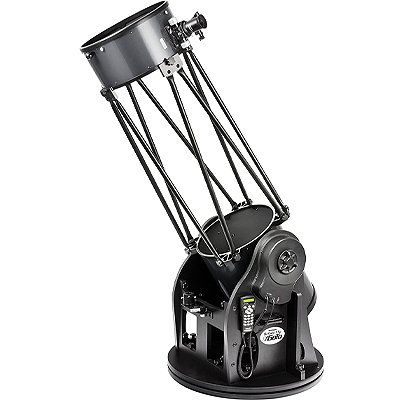
Orion SkyQuest XX16g is a colossal piece of hardware.
Comes with a really large aperture, and great focal length are sometimes too big.
You should be prepared to lift heavy weights or always have a helping hand next to you for transport and assembly.
The secondary mirror is very heavy and very bulky to transport.
If you are doing it alone, full unpacking and assembly could take up to 20 min. When pointed at zenith, the eyepiece is at 72 in. (182 cm) from the ground, that means some of you’ll need small steps in order to get to the eyepiece.
The full GoTo motorized base makes this scope very unique in features and capabilities. In the beginning, you should set up the system by aligning with 2 stars and enter the current date and time.
After alignment, you can use it as a GoTo system or regular Dobsonian by moving it manually. Luckily for this scope, there is a ‘closed-loop’ system that detects the manual movement of the scope, so you never lose alignment. There are very useful tension adjustments for nice and smooth manual panning and lifting.
What we liked
- Mammoth 16” mirror
- 4x more light than 8” telescope
- Amazing for DSO and planets
- 8 trusses for rigidness
- Full GoTo functionality
- Closed-loop system for manual use
- 42,000 object in the database
- Base breaks in 4 sections for better transport
- Alt-az tension adjustments
- Very compact scope and base
- Designed for maximum portability
What we didn’t like
- 2x more expensive than regular 16” Dobsonian
- 15-20 min. to full unpacking and assembly
- Cloth shroud not included
- 12V battery not included
Type: GoTo Truss Tube Dobsonian Telescope
Aperture: 16”
Focal length: 1800 mm
Focal ratio: f/4.4
Limiting stellar magnitude: 15.7
Weight: 174.0 lbs. (79 kg)
What’s special about it: Very compact when disassembled, great portability for that telescope size, extremely powerful telescope, made for DSO observing.
Also read:
- 5 Best Solar Telescopes in 2020 [to Observe The Sun]
- 5 Best Schmidt Cassegrain Telescopes Worth the Money (2020)
- 5 Best Telescopes for Viewing Planets in 2020 [Saturn, Mars, Jupiter, etc.]
Eyepieces for Deep Space Objects
Telescopes work by collecting light and bending the rays to bring them to focus. The eyepiece is the device that delivers this light to your eye to see the image. As you will see from the high power telescopes we reviewed above, many of them come with more than one eyepiece.
The size of the eyepiece together with the focal length of the telescope determines how magnified and clear your image is. Good observation does not always require huge magnification. In fact, sometimes a very large magnification results in a blurred image.
Good eyepieces for deep space observation range from 6mm, to 10mm, 15mm and 25mm.
6mm – 10mm eyepieces work well for all objects including brighter nebula and deep space galaxies. 15mm – 25mm eyepieces offer a great mid range magnification to view globular clusters, galaxy details and planetary nebulae.
Here are 3 best eyepieces for deep space telescopes:
- Low price range: Meade Instruments 07174-02 Series 4000 20mm Super Plossl Eyepiece. This is a low-priced eyepiece that offers Long Eye Relief, 7-Layer Multi-Coating & Edge-Blackened Optics. It has a Soft Rubber Eye Guard with included Bayonet Mount.
- Mid price range: The Celestron – Zoom Eyepiece for Telescope offers one eyepiece that adjusts from 8mm-24mm. It offers Low Power and High Power Viewing and works with Any Telescope that Accepts 1.25″.
- Well priced kit with 12 accessories: The Orion 08890 1.25-Inch Premium Telescope Accessory Kit offers a great choice of 12 premium accessories for any telescope. It includes 5 eyepieces, 6 eyepiece filters, and a versatile Barlow lens.
How to view deep sky objects?
Deep-sky objects or sometimes called deep space objects can be viewed quite easily. Most people tend to buy the largest telescopes in order to have a better view of those faint DSOs. While that is mostly true, you can start with any kind of binoculars, and even the smallest one can help, you just need to know the position where to look for them.
Position
No matter what kind of instrument you are using for hunting DSOs, knowing the position is always the key, and sometimes you’ll have to know what to look for, knowing the appearance of the object you are looking for can be crucial, like brightness, size, and form, because it can happen that your object is in your field of view, but you can’t recognize or even notice it. For that, you’ll need experience.
Aperture
Unlike observing planets where you need the largest magnification possible, here, in deep sky observing, you need the largest aperture possible in order to have a better contrast of those faint objects.
Narrowband filters
Also, a very important element in deep space observing is using narrowband filters. Maybe these are the most important accessories in your ‘deep-sky arsenal.’ With narrowband filters, you’ll get much better contrast, more details, and when changing different filters (wavelengths), you’ll notice different features and characteristics. I would recommend using UHC, O-III, and H-beta filters.
Quality of the sky
Another important factor while observing deep-sky objects is the quality of the sky, light-polluted areas near large cities are something you should avoid. In most cases, you should go more than 5 miles away from the city lights in order to have a moderate quality sky. In situations like this, narrowband filters are almost a must in order to filter out unwanted light pollution.
What’s the best type of telescope for observing deep space objects?
A Dobsonian reflector telescope is probably the only contender out there. This type of reflecting (Newtonian) telescope is the best of its kind for visual observing the DSO. Its design, easy to use, portability and lightweight large objective mirrors make it very popular among amateur astronomers.
If you are considering refracting telescopes, you can use them, but they are a bit more expensive at larger apertures and not so portable. Big refractors are not intended for visual observing of deep-sky objects. If you already own one, you can always use it, with some wisely chosen eyepieces even the cheapest refractor can give you some enjoyable view of the night sky.
You can also use catadioptric telescopes, but those are very expensive with bulky design in general and heavy mounts. Although someone not familiar with ‘star-hopping’ could have use of its GoTo mount for locating DSO, you can have a Dobsonian with GoTo base. But then again, where’s the fun without star hopping?
A quick tip: Almost every DSOs are observed black and white, there is no hue. Don’t expect to see any color like the images from astrophotography. That’s because we are using only night sight photoreceptor cells.
Dobsonian telescopes are synonymous with visual observing deep sky objects. With a nice set of eyepieces and proper narrowband filters, that will be everything. You’ll ever need for 99% of the nebulae. What about the remaining 1%? For that, you’ll need some additional $40 for a basic pair of binoculars.
On the other side of the spectrum, you have the binoculars, yes even the smaller ones like 8X40 (8 X magnification, 40 mm aperture) can be used to enjoy the night sky at the largest galaxies, star clusters, and nebulae. I would always recommend using a tripod for stargazing when you have greater magnification than 8.
In my opinion, 10X50 and 11X70 are the most suitable for astronomy. You can also opt for the more expensive, high-performance astronomy binoculars like 25X100, but for those, a more advanced tripod is a must. For astronomy, sometimes the ultra-wide field of view is spectacular; that’s why I would also recommend 4X30 for nice stellar nightscapes of the Milky Way.
Aperture is the key
Oh, yes! The larger, the better.
Telescopes are light-gathering buckets that are channeling the photons to your retina. If you double the aperture size, you are quadrupling the light-gathering power… more light means you’ll see fainter details, and the object will have a higher contrast.
In my experience, telescopes with 6” aperture are a great place to start, 12” are my favorite where you have the best ratio of price/performance/portability, there are some really compact and portable telescopes. Apertures between 12” and 16” is the sweet spot for the best price/performance ratio, from 12” to 16” you are doubling the light-gathering power and doubling the price, so you can choose whether you’ll lean towards budget or towards performance.
Dobson refracting telescopes with apertures 18” and larger are more than just a commodity, that’s where you are paying a premium for every percent of increment. You must know that with doubling the size, you won’t get even two limiting magnitudes.
So the difference from 12” to 16” telescope, the limiting magnitude will jump just from 14.8 to 15.5, but the price will be double. That’s why I use my 12” scope 8 out of 10 times while going stargazing, it’s powerful enough not to notice a lot of difference to 16,” but it’s very compact for easy transport.
Don’t forget the filters
Often overlooked for visual astronomy, narrowband fIlters are possibly the best astronomy accessories that you will have. Those little glasses are small and somewhat expensive, especially the 2” versions, but I’m sure you’ll find a good use for them. Narrowband filters are a must if you want to minimize the light pollution or you want to see different details on some of the nebulae.
There are three kinds of narrowband filters most used for visual observation and possibly the only ones: UHC, O-III and H-beta.
- UHC (Ultra High Contrast) filter is suitable for almost every DSO except for stars, double stars and some of the open star clusters. This filter cuts out the light pollution and some of the atmosphere glow, so you’ll get a better contrasted view. You can use it for any object that has nebulosity like galaxies, diffuse nebulae, as well as star clusters, but in star clusters, you are cutting away some of the starlight as well.
- O III filter is probably the highest contrast filter you can use. It filters out everything but the certain wavelength of doubly ionized oxygen (green hues) where most of the emission nebulae are brightest, like planetary nebulae, supernova remnants and stellar nurseries (H II regions). This filter is not for galaxies, stars nor any kind of star clusters.
- H-beta filter is not that spectacular like the O III filter, mostly because there is not much radiation at that wavelength compared to H-alpha, that’s why this filter can be used for the brightest objects only. This filter is good only for stellar nurseries (H II regions) where hydrogen is strongly ionized.
There is one more filter called CLS, this one is not that popular now because it’s not filtering enough of the light pollution. This one was very useful against light pollution from those orange street lights (sodium lamps) that are rarely used today. That’s why nowadays CLS is almost obsolete.
How to choose the right deep space telescope?
Well, that’s easy. Just buy the largest aperture Dobson telescope for your budget, and you are set.
That’s funny but also a really honest and helpful answer, now let’s elaborate when you should choose one characteristic over another.
- Aperture – in visual observing, this is the most important thing you should focus on wider aperture, more light, more contrast, more details.
- Focal length – the higher focal length you have, the better clarity and higher angular separation will be.
- Field of view – this will be determined with the eyepieces. Their apparent field of view and focal length will give you the true field of view of the scope.
- Mount – Dobsonian telescopes use rocker bases that are a very cheap but very practical design. Some rocker boxes can be better and a lot smoother than others because of their design and materials used.
- Portability and weight – this is probably the most important factor that doesn’t affect the viewing quality but can affect your willingness to go out and use it.
First of all, telescopes for visual observing the night sky are a lot cheaper. Their optics are not so refined like on the telescopes for astrophotography and all the other parts are either missing or are a lot cheaper. They don’t have the complex, steady, and motorized mounts. You don’t need guiding scopes or other anti-dew electronics. You don’t need expensive imaging and capturing devices. Telescopes for astrophotography can be used for visual observing, but their prices will be much higher with specs that are much worse.
Because better scopes can get really big, really fast, that’s why you should be aware of the portability, sometimes you might pay a premium for more compact design telescope over bulky scope with the same characteristics.
Smaller scopes are great for the largest and brightest DSO. You might ask why? Because you can achieve a very wide field of view with the shorter focal length for the largest deep sky objects, like the Andromeda galaxy, the Orion nebula, the Pleiades, Double Cluster in Perseus, etc.
Frequently asked questions
What is the best telescope for deep space viewing?
For a family, the Orion StarBlast 4.5 Astro Reflector Telescope is the best space telescope and is well priced.
What is the best telescope for deep sky objects?
We highly recommend the Orion SpaceProbe 130ST EQ Reflector Telescope for deep sky space objects. It offers exceptional value for money and has a 5.1″ aperture.
How big of a telescope do you need to see galaxies?
For observing galaxies, a telescope with an eyepiece of 13mm – 25mm and a focal length of 800mm – 1200mm will be ideal.
Can you see nebula with a telescope?
Yes, you can see nebula with a telescope! Use your Star Guide software to locate and pin-point exciting nebula like the HorseHead Nebula in the constellation of Orion.
What is the best telescope for deep space astrophotography?
The best telescope for deep space astrophotography is the Orion 8″ f/3.9 Newtonian Astrograph Reflector Telescope. It has a large 8” aperture and advanced software features.
What is the most powerful telescope you can buy?
The Celestron NexStar 8SE Telescope Computerized Telescope is an extremely powerful best deep space telescope for beginners and advanced users. It carries a price tag of over $1000 and will give a lifetime of viewing pleasure.
How big of a telescope do I need to see Andromeda?
The Andromeda Galaxy is a bright celestial object that you can view using an entry-level to intermediate telescope with an aperture of 4 to 8 inches. Bigger scopes will allow you to see more detail, including the individual stars. See our list of space telescopes for well priced models.
What eyepiece is best for galaxies?
The Celestron Zoom Eyepiece is great for viewing galaxies. It adjusts from 8mm to 24mm, depending on your viewing needs, giving you all the flexibility you want in one eyepiece.

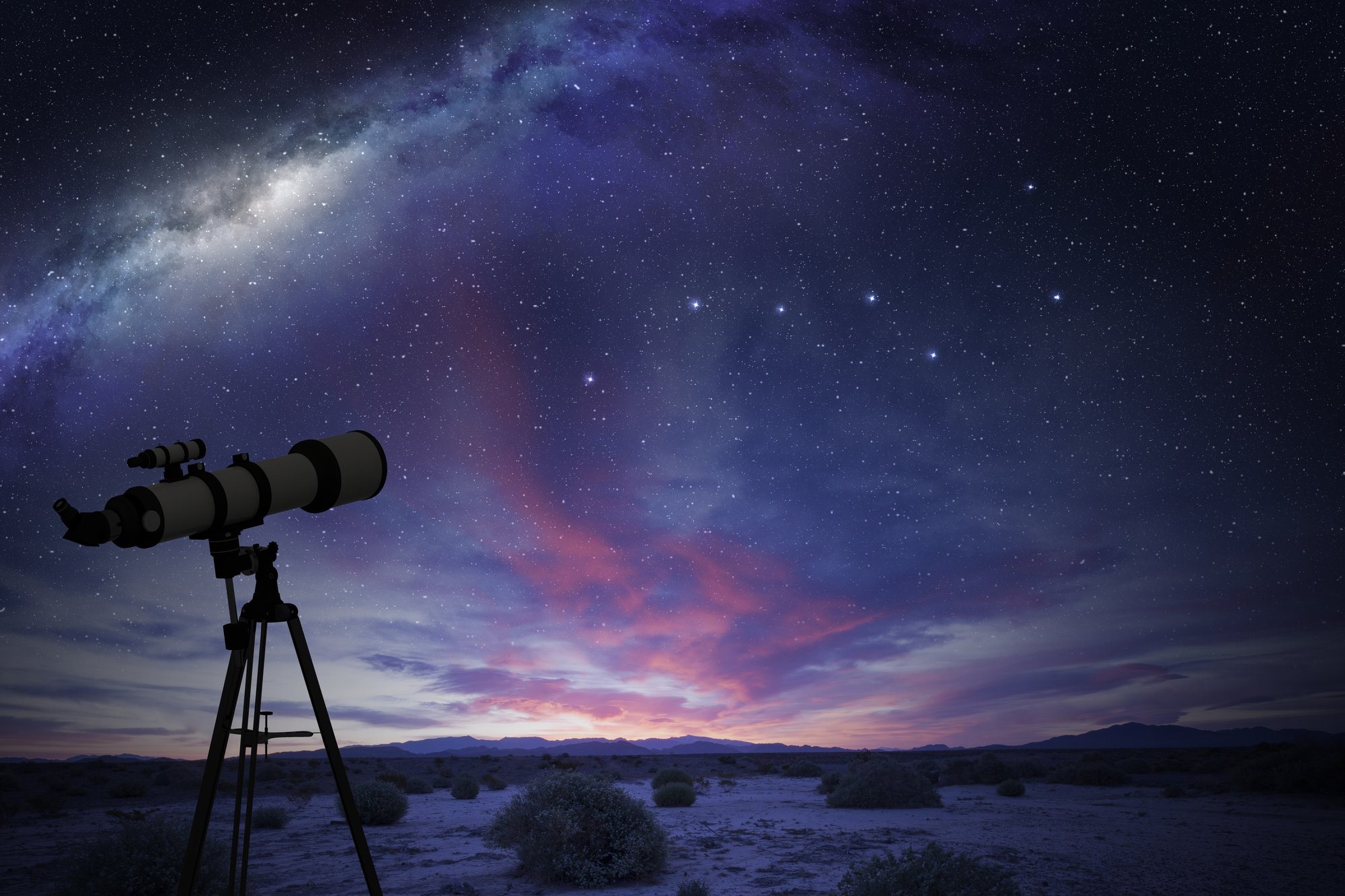



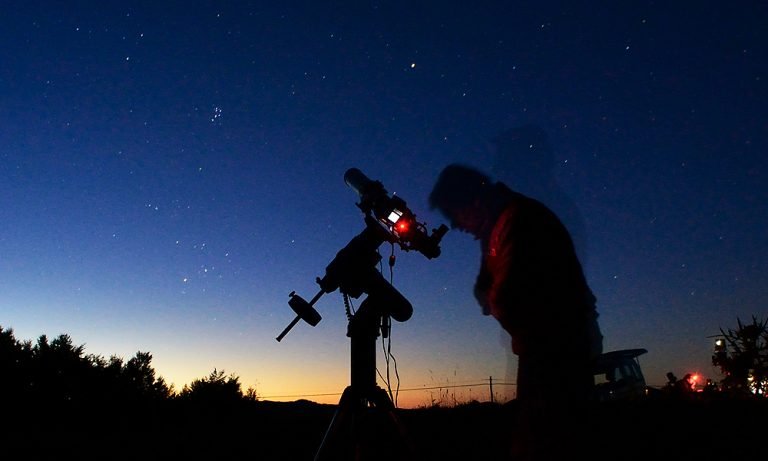
![12 Best Beginner Telescopes in 2024 [Actually Simple to Use]](https://www.planetguide.net/wp-content/uploads/2020/06/rfe-768x488.jpg)
![12 Best Budget Telescopes in 2024 [Maximum Value for Money]](https://www.planetguide.net/wp-content/uploads/2019/12/refreactor-telescope-768x461.jpg)
![5 Best Solar Telescopes in 2024 [to Observe The Sun]](https://www.planetguide.net/wp-content/uploads/2020/01/solar-telescope-768x461.jpg)
![12 Best Travel Telescopes in 2024 [Portable & Durable]](https://www.planetguide.net/wp-content/uploads/2019/12/best-travel-telescope-768x461.jpg)
